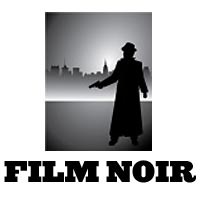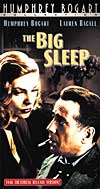 Noirs with Raymond Chandler's 'Philip Marlowe': Noirs with Raymond Chandler's 'Philip Marlowe':
Over the years from 1939 to 1958, Raymond Chandler
wrote seven full-length
Philip Marlowe novels about the popular, hard-drinking detective-gumshoe
- a PI sleuth. His works set the standard for the "hard-boiled" and
world-weary detective character and his milieu.
Six of Chandler's books were adapted into feature films
(several more than once), and many different actors have portrayed
the hard-drinking PI in theatrical films, including:
- Dick Powell
- George Montgomery
- Robert Montgomery
- Elliott Gould
- Robert Mitchum
(twice)
- James Garner
- Humphrey Bogart
|
Raymond Chandler's Seven Full-Length Philip Marlowe
Novels
|
Chandler Novel
(7 in total)
|
Date of Novel
|
Title and Date of Film
and Director
|
Actor Who Played Marlowe
|
Film Notes
|
|
(1) The Big Sleep
|
1939
|
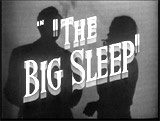
The
Big Sleep (1946)
d. Howard Hawks
|
Humphrey Bogart
|
- confusing, classic Howard
Hawks who-dun-it, and a tale of blackmail, pornography,
and murder in Los Angeles
- adapted for the screen by co-writers William
Faulkner, Leigh Brackett and Jules Furthman
- Bogart was teamed with real-life wife Lauren Bacall |
|
|
|
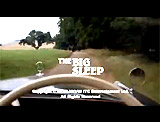
The Big Sleep (1978, UK)
d. Michael Winner
|
Robert Mitchum
|
- a UK remake of Howard Hawks' 1946
film
- Mitchum's 2nd portrayal of Marlowe
- with Candy Clark and Sarah
Miles as the two Sternwood daughters, and Oliver Reed as corrupt gangster
Eddie Mars |
|
(2) Farewell, My Lovely
|
1940
|
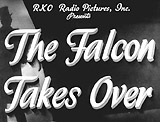
The Falcon Takes Over (1942)
d. Irving Reis
|
George Sanders as Gay Lawrence
(not as Philip Marlowe)
|
- it was the first of three film versions of Chandler's Farewell,
My Lovely
- based on Chandler's book, Farewell,
My Lovely, and on novelist Michael
Arlen's 1940 fictional crime short story Gay Falcon
- the protagonist was Gay Stanhope Falcon (later renamed
Gay Lawrence) rather than Philip Marlowe
- it was the third installment in the Falcon series
of four films from 1941 to 1942 starring George Sanders; in all, there were 16 Falcon films
from 1941 to 1949, with Sanders and two other actors (Tom Conway as Tom Lawrence
and John Calvert as Michael Waring) |
| |
|
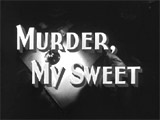
Murder, My Sweet (1944)
(aka
Farewell, My Lovely)
d. Edward Dmytryk
|
Dick Powell
|
- the film, a twisting story of intrigue, was
especially noted for its expressionistic lighting and flashback
structure
- singer Dick Powell starred in an against-type role as the down-and-out PI searching
for paroled ex-con Moose Malloy's (Mike Mazurki) missing lover Velma/Helen Grayle
(Claire Trevor) in wartime Los Angeles |
|
|
|
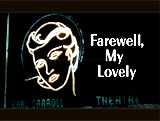
Farewell, My Lovely (1975)
d. Dick Richards
|
Robert Mitchum
|
- shot in color, a remake of The Falcon Takes
Over (1942) and Murder, My Sweet
(1944)
- set in Los Angeles in 1941
- with Charlotte Rampling as the seductive
Helen Grayle/Velma, Jack O'Halloran as Moose Malloy, and Sylvia Miles
(Best Supporting Actress-nominee) as Jessie Halstead Florian |
|
(3) The High Window
|
1942
|
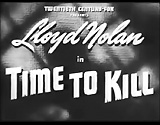
Time To Kill (1942)
d. Herbert I. Leeds
|
Lloyd Nolan as Michael Shayne
(not as Philip Marlowe)
|
- Marlowe was renamed Michael Shayne, a similar
gumshoe private detective
- this was a version of The Brashear Doubloon (1947)
- this was the last of a series of seven films from 20th Century
Fox (from 1940 to 1942), with Lloyd Nolan starring as Michael Shayne
|
|
|
|
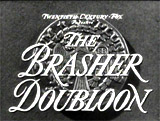
The Brashear Doubloon (1947)
(aka The
High Window)
d. John Brahm
|
George Montgomery
|
- technically a remake
of Time to Kill (1942) |
|
(4) The Lady in the Lake
|
1943
|
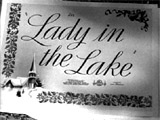
Lady in the Lake (1947)
d. Robert Montgomery
|
Robert Montgomery (also directed film)
|
- experimentally shot from the point
of view of Marlowe |
|
(5) The Little Sister
|
1949
|

Marlowe (1969)
d. Paul Bogart
|
James Garner
|
- the setting was 1960s Los Angeles
- with martial
arts expert Bruce Lee as the villain |
|
(6) The Long Goodbye
|
1953
|
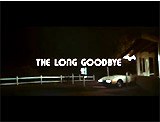
The Long Goodbye (1973)
d. Robert Altman
|
Elliott Gould
|
- a spoof film, set in modern-day Los Angeles
- the lone, unconventional
sleuth investigated the murder of a friend's wife |
|
(7) Playback
|
1958
|
none
|
|
- the only Chandler novel about Marlowe never
filmed |
[Note: Also, James Caan portrayed Philip Marlowe
in the HBO film Poodle Springs (1998), based on Chandler's
unfinished novel Poodle Springs - completed after his death
by Robert B. Parker and published in 1989. Even African-American
actor Danny Glover portrayed shamus Marlowe in the 1995 anthology
Showtime TV series Fallen Angels in an episode titled "Red Wind."]
Romance Film Noirs with Great Femme Fatales:
Twisted, shocking melodramatic film noirs featuring deadly femme fatales on a path of romance and self-destruction (romance noirs)
with the men in their lives included the following examples:
-
 Fritz
Lang's second American film You Only Live Once (1937) with a framed-for-murder,
doomed ex-convict Henry Fonda in flight to the border with loser wife Sylvia
Sidney and child Fritz
Lang's second American film You Only Live Once (1937) with a framed-for-murder,
doomed ex-convict Henry Fonda in flight to the border with loser wife Sylvia
Sidney and child
- Jean Renoir's classic, tragic, and film-noirish
crime drama La Bête Humaine (1938, Fr.) (aka The Human
Beast) about murder, guilt and adulterous infidelity in
a love triangle, adapted from Emile Zola's 1890 novel, starring
Jean Gabin as homicidal, tormented railroad engineer Jacques
Lantier - the "human beast," Le Havre deputy
station master Roubaud (Fernand Ledoux), and his sexy, manipulative
and troubled femme fatale wife Séverine Roubaud (Simone
Simon)
- William Wyler's The Letter (1940)
featured Bette Davis as a murdering wife whose professed innocence was compromised
by a damning letter
- Billy Wilder's (and Raymond Chandler's) adaptation of James
M. Cain's novel Double Indemnity (1944) included a persuasive, sinister brassy
blonde (Barbara Stanwyck) who convinced a smart-talking insurance agent/lover
(Fred MacMurray) to murder her unsuspecting husband so they could share
'double indemnity' insurance proceeds; also with Edward G. Robinson as a
shrewd insurance investigator
- Fritz Lang's tense The Woman in the Window (1944) told about a law-abiding college professor (Edward G. Robinson) who became
embroiled in a crime when he unintentionally committed a murder and suddenly
found himself on the run from blackmail with a beautiful, strange model
(Joan Bennett)
- Michael Curtiz' melodramatic, mother-daughter noir classic Mildred Pierce (1945) featured Best Actress-winning
Joan Crawford as a suspected murderess who covered up for her beloved but
venomous femme fatale daughter (Ann Blyth)
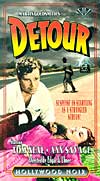 the
psychological, melodramatic noir Leave
Her to Heaven (1945), one of the first noirs shot in color,
highlighted a menacing, father-fixated, unstable femme fatale (Gene
Tierney) who would stop at nothing (the drowning murder of her
husband's younger paraplegic brother in a Maine lake, and a deliberate
miscarriage to kill her unborn child when she deliberately fell
down stairs) to possessively hold onto the man she loved the
psychological, melodramatic noir Leave
Her to Heaven (1945), one of the first noirs shot in color,
highlighted a menacing, father-fixated, unstable femme fatale (Gene
Tierney) who would stop at nothing (the drowning murder of her
husband's younger paraplegic brother in a Maine lake, and a deliberate
miscarriage to kill her unborn child when she deliberately fell
down stairs) to possessively hold onto the man she loved- Edgar G. Ulmer's gritty, cheaply-made ("Poverty
Row"),
fatalistic, cultish crime film Detour (1945) was about the
bleak twists of fate; in a flashback story cynically narrated, a
world-weary, identity-stealing hitchhiker (Tom Neal) was haplessly
involved in an ambiguous death during his thumbing trek to Los Angeles,
and later became involved with a nasty hitchhiker - the film's blackmailing,
vindictive femme fatale con Vera (Ann Savage) whom he accidentally
strangled with a telephone cord through a closed door; [Note: the
film was remade as Detour (1992) and
starred the son of the original ill-fated protagonist, Tom Neal,
Jr.]
- Tay Garnett's stylish and moody The
Postman Always Rings Twice (1946), from James M. Cain's novel, starred
"sweater girl" Lana Turner as the libidinous, restless platinum
blonde wife Cora Smith - who was stuck in a roadside diner and loveless marriage and convinced
her illicit lover Frank Chambers (John Garfield) to murder her good-hearted
husband Nick (Cecil Kellaway)
- in Lewis Milestone's The Strange Love of Martha Ivers
(1946), Barbara Stanwyck's murderous past might be revealed by her alcoholic,
unrespected attorney husband Kirk Douglas
- Rita Hayworth was featured in a sultry performance
as the black glove-stripping Gilda (1946) to
the tune of "Put the Blame on Mame" in Charles Vidor's
classic film noir of a love triangle - the 'love goddess' portrayed
the sexy, hedonistic red-headed wife of South American casino owner
Ballin Mundson (George Macready) who became involved with her husband's
abusive croupier (Glenn Ford) - her ex-beau. She became notorious
for her much-quoted line: "If I'd been
a ranch, they would have named me the Bar Nothing"
- Robert Siodmak's adaptation of Ernest Hemingway's 1927
short story of a twisting double-cross, The Killers
(1946), featured Burt Lancaster (in his film debut as the doomed
ex-boxer Ole "the Swede" Andersen) and the stunning Ava Gardner
as the manipulative vixen Kitty Collins (who was quoted as saying: "I'm
poison, Swede, to myself and everybody around me"); it was noted
for its exceptional beginning in which the Swede was assassinated
by two professional killers - and accepted his death stoically. [This
film was remade by director Don Siegel as the violent crime noir
thriller The Killers (1964) with Lee Marvin, Ronald Reagan (in his last feature role), and Angie Dickinson]
 in
director John Cromwell's Dead Reckoning (1947), an on-the-run WWII
veteran's alluring Southern girlfriend (Lizabeth Scott) threatened military
buddy Humphrey Bogart in
director John Cromwell's Dead Reckoning (1947), an on-the-run WWII
veteran's alluring Southern girlfriend (Lizabeth Scott) threatened military
buddy Humphrey Bogart- director Jacques Tourneur's quintessential, slick film
noir Out of the Past (1947) (aka Build My Gallows High) of
underworld intrigue was filled with complex flashbacks; it featured Robert
Mitchum as the doomed, double-crossed ex-private eye Jeff Markham with a
sordid past who fell for the icy femme fatale Kathie Moffat (Jane
Greer) he was trailing for ruthless gangster Whit Sterling (Kirk Douglas);
Markham knew the dangers of falling in love with her ("You're like
a leaf that the wind blows from one gutter to another"); [remade as Against All Odds (1984) with an older Jane Greer as her original
character's mother]
- Nicholas Ray's doomed lover film They Live By Night
(1949) starred Farley Granger and Cathy O'Donnell as fugitive, misfit
criminals on the run [remade as Thieves Like Us (1974)]
- Joseph H. Lewis' tabloid romantic/crime B-movie melodrama Gun Crazy (1949) (aka Deadly Is the Female) - was another amour fou 'Bonnie and Clyde' tale with two disturbed and doomed protagonists/lovers
on a crime spree - gun-loving Bart (John Dall) and blonde carnival sharpshooter
(Peggy Cummins); noted for one unbroken take filmed in the getaway car during
a bank robbery scene
- Billy Wilder's classic black comedy and film noirish drama Sunset Boulevard (1950) was a "behind the scenes" look at Hollywood and the price of fame, greed, narcissism, and ambition; down-on-his-luck B-movie hack screenwriter Joe Gillis (William Holden) spoke (in flashback with voice-over narraton) beyond the grave as a dead man floating face-down in a swimming pool in Beverly Hills, about his six-month struggle to produce screenplays to meet the demands of the industry and satisfy the thirsty illusions of immortality and comeback of aging, waspish, megalomaniacal silent film queen (and femme fatale) Norma Desmond (Gloria Swanson) in her decaying Sunset Boulevard mansion
- Otto Preminger's Angel Face (1953) starred Jean
Simmons as a psychotic 'angel of death' who talked chauffeur Robert Mitchum
into a murder scheme
- Henry Hathaway's Techni-colored noir Niagara (1953) provided the perfect star vehicle for curvy sexpot Marilyn Monroe as Rose
Loomis, a sinfully-wayward, unhappily married woman (to unstable, WWII veteran George (Joseph Cotten)), in its tale of murder and sexual jealousy;
one of its taglines proclaimed: "A raging torrent of emotion that even
nature can't control!"
Documentary-Style Noirs:
There are numerous, pseudo documentary-style film noirs ("docu-noirs"), often
set in dark, rain-swept, crime-ridden urban areas, made in a realistic,
semi-documentary fashion and often filmed in actual locations of real-life events:
- Henry Hathaway's docu-drama The House on 92nd Street (1945) about Nazi spies scheming to learn the atom bomb formula, was based on actual FBI cases
- Henry Hathaway also directed the film noirish Kiss of Death (1947), was derived from Stoolpigeon - a story by Eleazar Lipsky (with a screenplay by Ben Hecht and Charles Lederer); Victor
Mature starred as paroled robber Nick Bianco opposite chilling, sadistic
gangster Tommy Udo (Richard Widmark in his stunning screen debut, noted
for the scene in which he giggled hysterically while pushing a wheelchair-bound
old woman down a flight of stairs)
 Call
Northside 777 (1948), another Henry Hathaway-directed film
(based on a true story), starred James Stewart as dogged Chicago
reporter P.J. "Mac" McNeal who uncovered a police coverup that
sent Frank Wiecek (Richard Conte), a wrongly-convicted, innocent
man to jail for killing a cop eleven years earlier in 1932;
he originally investigated an ad in which Frank's mother Tillie
Wiecek (Kasia Orzazewski), offered $5,000 for new evidence
to clear her son, causing "Mac" to become increasingly certain
that Frank was unduly imprisoned Call
Northside 777 (1948), another Henry Hathaway-directed film
(based on a true story), starred James Stewart as dogged Chicago
reporter P.J. "Mac" McNeal who uncovered a police coverup that
sent Frank Wiecek (Richard Conte), a wrongly-convicted, innocent
man to jail for killing a cop eleven years earlier in 1932;
he originally investigated an ad in which Frank's mother Tillie
Wiecek (Kasia Orzazewski), offered $5,000 for new evidence
to clear her son, causing "Mac" to become increasingly certain
that Frank was unduly imprisoned- Crane Wilbur's crime drama Canon City (1948) - a
re-enactment of a 1947 prison escape in Colorado
- director Jules Dassin's great crime drama The Naked
City (1948) featured Barry Fitzgerald as a New York City cop investigating
a murder over six days, and climaxed with a suspenseful chase and shootout
on the Williamsburg Bridge
- Anthony Mann's documentary style crime noir T-Men (1948) told about two undercover US Treasury men (Dennis O'Keefe and Alfred Ryder) who infiltrated a deadly counterfeiting gang; in one memorable scene, one of the T-Men was executed while his partner watched
- the little-seen Abandoned (1949), from director
Joseph Newman, about a late 1940s LA newspaper reporter (Dennis O'Keefe)
pursuing a missing girl, along with her sister (Gale Storm known for the
TV series My Little Margie), into the sordid black-market baby adoption
racket, while encountering a corrupt private investigator (Raymond Burr)
- Alfred L. Werker's (and uncredited Anthony Mann) police procedural film noir He Walked By Night (1949) was the story of the capture of psychopathic killer Erwin "Machine-Gun" Walker; the film inspired actor Jack Webb to create Dragnet - first a radio show and then a TV cop show
- also, Joseph Newman's moralistic urban crime drama 711
Ocean Drive (1950) told about the rise and fall of
an organized crime kingpin (Edmond O'Brien as a telephone company repairman
turned bad); the film capitalized on various book-making scandals at the
time sensationalized and exposed in the newspapers; with on-location settings
of L.A., Palm Springs and Nevada, particularly at Hoover Dam
- Billy Wilder's Ace in the
Hole (1951), an insightful expose of the media, starred Kirk
Douglas as a cynical and immoral newsman named Charles 'Chuck' Tatum
who exploited a 'human interest' story to the public by orchestrating
a media frenzy around a man trapped in a Pueblo cliff dwelling tunnel-cave
collapse
- Alfred Hitchcock's noirish, true-life story thriller The Wrong Man (1956) with Henry Fonda as a New York musician framed and wrongly-accused of committing
armed robbery - and undergoing a nightmarish ordeal, including the mental breakdown of his wife (Vera Miles)
Prison Noirs:
Noirs have sometimes been set in prisons or jails:
- in Mervyn LeRoy's I Am a Fugitive
From a Chain Gang (1932), an innocent WWI veteran (Paul Muni) was
wrongly imprisoned as a chain gang convict, and after two escapes faced
life as a hunted fugitive; also the earlier RKO release by Rowland Brown, Hell's Highway (1932) - with a similar bleak view of a Southern chain-gang
prison
- Fritz Lang's message film Fury (1936) - his first
American film - with Spencer Tracy as a falsely accused kidnapper who was
threatened and nearly-lynched by a mob in a small Midwestern town
- Jules Dassin's dark prison drama Brute Force (1947) - more harsh than
noirish about the oppressive Westgate prison (headed by ruthless and sadistic chief guard Captain Munsey (Hume Cronyn)) with Burt Lancaster as an inmate
seeking to escape to be with his critically-ill girlfriend
Menaced-Women Noirs:
In menaced-women noirs, the tables are turned and women are
menaced by the men in their lives (often their husbands), as in these examples:
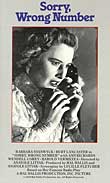 in
George Cukor's Gaslight (1944), Ingrid Bergman
was driven to near insanity by her menacing, mentally-cruel husband Charles
Boyer in
George Cukor's Gaslight (1944), Ingrid Bergman
was driven to near insanity by her menacing, mentally-cruel husband Charles
Boyer- in Otto Preminger's hard-edged noir romance Laura
(1944), a police detective (Dana Andrews) investigated socialite
Laura's (Gene Tierney) murder until she reappeared - and was threatened
a second time; the film contained troubling necrophiliac themes and sexual
obsession by the hard-boiled detective for the dead woman; with a great
supporting cast including Vincent Price, Clifton Webb, and Judith Anderson;
Oscar winner for Best B/W Cinematography
- in Anatole Litvak's unnerving and tense Sorry, Wrong
Number (1948), bed-ridden hypochondriac/heiress Barbara Stanwyck overheard
a phone call plot that her weak husband Burt Lancaster planned to kill her
- in Nicholas Ray's In A Lonely Place (1950),
Humphrey Bogart portrayed a burned-out, troubled, hot-tempered,
and near-psychotic Hollywood screenwriter and murder suspect while
having an affair with neighboring, alibi-providing, aspiring blonde
starlet Laurel Gray (Gloria Grahame) - their sexual attractiveness
to each other was soon torn apart by jealousy, fear, and suspicion
|
